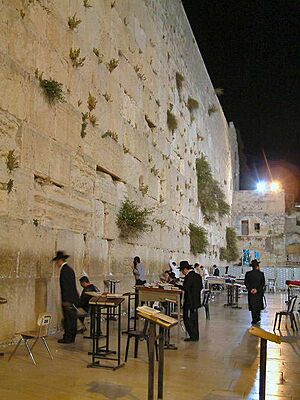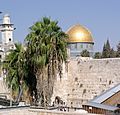Western Wall facts for kids
The Western Wall, also known as the Wailing Wall or Kotel (which means "the Wall" in Hebrew), is a very old and special wall in the Old City of Jerusalem. It stands on the western side of a holy area called the Temple Mount. For Jewish people, this wall is believed to be a remaining part of the Second Temple in Jerusalem, which was destroyed a long, long time ago. Because of its history, it is considered the most holy site where Jews can pray.
- Western Wall
Contents
A Special Place for Prayer
The Western Wall is a very important place for Jewish people around the world. Many come here to pray, reflect, and connect with their history. It's a place where people feel close to God and their heritage.
How People Pray at the Wall
When people visit the Western Wall, they often:
- Pray silently or out loud.
- Read from holy books like the Torah.
- Place small notes with prayers or wishes into the cracks between the ancient stones. This tradition is very old and meaningful.
- Celebrate special events like Bar Mitzvahs (a coming-of-age ceremony for boys).
Separate Prayer Areas
The prayer area at the Western Wall is divided into two sections:
- A larger section for men.
- A smaller section for women.
This separation is a tradition in many Jewish places of worship.
History of the Wall
The Western Wall is part of the retaining wall that supported the Temple Mount plaza. This plaza was built by King Herod the Great around 20 BCE (Before Common Era). The Second Temple stood on this plaza until it was destroyed by the Romans in 70 CE (Common Era).
What Remains Today
The part of the wall that we see today is not the actual temple building. Instead, it is a strong supporting wall that helped create the large platform where the temple once stood. Over time, this wall became the most accessible and important part of the Temple Mount for Jewish prayer.
The Wall Through the Years
For centuries, the Western Wall was a narrow alleyway, surrounded by houses. People would gather there to pray, often in difficult conditions.
- In 1917, after the British took control of Jerusalem, Jewish soldiers visited the Wall.
- In 1928, there were disagreements about prayer arrangements at the Wall.
- After the 1948 Arab-Israeli War, the Old City of Jerusalem was controlled by Jordan. During this time, Jews could not visit the Western Wall.
- In 1967, during the Six-Day War, Israel gained control of the Old City. This allowed Jewish people to visit and pray at the Wall freely again.
The Western Wall Plaza
After 1967, the area in front of the Western Wall was cleared. This created a large open plaza. This plaza allows many thousands of people to gather and pray at the Wall at the same time. It has become a central place for national and religious ceremonies in Israel.
Other Parts of the Wall
The Western Wall is much longer than the part seen in the main plaza. Much of it is hidden underground.
- The Western Wall Tunnels allow visitors to explore more of the ancient wall. These tunnels show parts of the wall that are much older and deeper.
- Robinson's Arch is another part of the Western Wall. It was once part of a large staircase that led up to the Temple Mount. Today, you can see its remains and excavated streets below. This area is also used for prayer, especially by groups who prefer a different prayer style.
Images for kids
-
A wide view of the Western Wall with the Dome of the Rock (left) and al-Aqsa mosque (right) in the background.
-
Jewish Legion soldiers at the Western Wall after the British took Jerusalem in 1917.
-
An iconic photo of Israeli soldiers shortly after capturing the Wall during the Six-Day War.
-
U.S. president Donald Trump visiting the Western Wall in 2017.
See also
 In Spanish: Muro de las Lamentaciones para niños
In Spanish: Muro de las Lamentaciones para niños
































